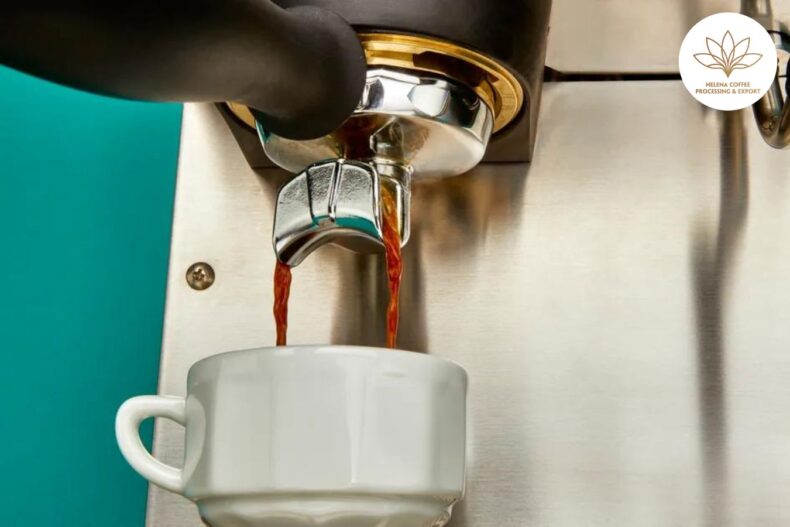
How To Grind Coffee For Espresso: Before any brewing method, each coffee bean must pass through the grinder, and if the grinding is not done correctly, the heat generated by high friction will burn the coffee, resulting in a large number of fine beans.
No matter how delicious, your coffee will be spoiled at this point due to (fines) or varying bean sizes. Even if you buy a dispenser or rely on Barista talents, the quality of Espresso cannot be improved because the coffee is ground too coarsely.
What is the best way to grind coffee for Espresso?
In the preparation of Espresso coffee, the grinder is very crucial. Espresso coffee is smoother than drip coffee, but it is brewed a fraction of the time.
This means that Espresso ground coffee requires a large surface area to extract enough in the time permitted, but it must also let water flow through the coffee layer, even when the beans are ground. Together, smooth and squeezed To achieve these two purposes, a specific grind size ratio is needed.
The fine particles provide enough surface area for extraction in the time allotted, and the bigger particles allow water to flow through the coffee mass (M Petracco 2005).
This contrasts traditional coffee processes, which often yield outstanding results from similarly sized coffee beans removed in equal proportions.
When grinding coffee powder, don’t overheat it.
Grinding coffee is the process of breaking down and crushing beans using a variety of forces, including the significant influence of friction. This process heats both the blade and the coffee. The coffee will burn if the temperature is too high, resulting in the transformation and spread of existing flavors.
Furthermore, it causes the oil from the coffee beans to exude a lot, forming clumps, resulting in dry patches of the coffee during extraction (Due to the clumped parts not being able to absorb boiling water).
Coffee oils are thick at ambient temperature, but they become more liquid beyond 40°C, according to Illy’s Espresso Coffee: The Science of Quality (M Petracco, 2005). Oil can easily leak out of the beans through minute fissures, coating the outer surface with a sticky layer, and causing the coffee powder to clump and clump. As a result, the extraction of these particles may become less uniform, increasing flow resistance.
On the other hand, temperature variations cause dose, extraction, and flavor irregularities. As a result, rather than attempting to chill the blender as quickly as possible, a more practical method is to strive to stabilize the temperature as much as feasible.
Size Distribution of Particles (PSD)
The homogeneity of the beans represents the change in the size of coffee beans after grinding (Grind Size Distribution or Particle Size Distribution (PSD). PSD is a metric that indicates the grinder’s quality. The finer the grain, the more consistent it is.
The wider the difference in particle size and the higher the percentage of dust particles (Fine s) and large particles, the worse the machine ( Boulder ). There are too many big seeds in the extract; it becomes either over-flavored or excessively light and imbalanced.
The temperature influences the grain size distribution in the blender. According to barista hustle, coffee ground in a “hotter” grinder has fewer small particles, limiting extraction and negatively affecting the flavor.
Because coffee becomes more malleable and less brittle as it warms, it breaks down into more occasional pieces and creates fewer fines each time it is chopped or ground. This means that certain larger particles will have an easier time escaping.
Suppose the coffee is too large after grinding. In that case, the water flow under high pressure always creeps through the least hindered regions (where large particles are concentrated) compared to the remainder of the coffee, resulting in uneven extraction. When producing Espresso, the phenomenon of water flow through these “drainage canals” is known as Channeling, and specific careful manipulations can minimize it.
Fines affect espresso extract
Espresso has a grain size that is slightly larger than conventional Turkish brewing methods (coffee is ground, so OK that it cooks with water without filtering). As a result, small particles have a more significant impact on the quality of espresso extract than large particles.
Fines are minute particles created when coffee is ground (less than 100 micrometers in diameter). Fines play a crucial part in the extraction of Espresso. With a reasonable number of fines in the extraction process, under the influence of high pressure, these particles will follow the water to the basket’s bottom, providing a natural coating and avoiding uneven flow (Channeling).
For a more balanced flavor and more steady extraction Meanwhile, if the acceptable particle ratio is too high, the flow would be disrupted altogether, resulting in clogging ( Compact layer).
Fines migration refers to the phenomena of fines sliding lower during extraction. Is there a method to keep fines from migrating? – Yes, by steadily pressurizing (Preinfusion) the extraction in the early phases. This is covered in greater depth in the article Pressure in Espresso Making. We can also use a sharper, bigger blade and grind slower to reduce tiny particles.
The Coffee Grinder’s Issues
So far, you’ve seen that Espresso necessitates a finer grind than any other brewing method, which means your grinder will have to put in a lot of effort and ensure consistency in quality between kinds.
When it comes to sound-quality coffee, there are a few more elements to consider because you won’t be able to save the quality of the coffee with a machine or professional labor if you choose a low-quality grinder.
Blender Alignment, Sharpness, and Size
After grinding, sharpener, disc size, and alignment significantly impact grain size distribution. Thus, they’re important to consider when choosing a grinder.
Sharpening edges that are worn and dull tend to ‘crush’ coffee beans with compression rather than scrape them with shear stress (compressive and shear stress, to be precise).
The coffee beans will shatter into arbitrarily sized pieces due to compression; therefore, blunt edges (on the sharpener) provide a vast particle size distribution, resulting in less uniform extraction. Sharper (sharper) edges generate a more consistent grind size distribution, grind faster, and are less susceptible to heat.
In terms of size, larger grinding discs generate a more uniform grind size distribution, grind faster, and cool down more quickly.
The impact of aligning the burrs to parallel the grind size distribution and coffee quality entirely is also considerable. If the burrs are not correctly aligned, particles of various sizes may escape from multiple ridge sections, resulting in significantly less uniform grain size.
Several blenders have joined the market in recent years with built-in cooling fans, motor and mill chamber cooling, or changeable grinding speeds, among other more difficult features that must be addressed. It is recommended to seek additional advice from the supplier.


